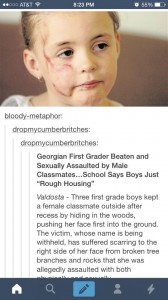By SHAKIRA MOLET
Recently, a story about a first grader being sexual assaulted by male classmates has been circulating the Internet. Unfortunately, there is one problem with this story. It’s not true.
 While scrolling through my dash in Tumblr, I found this post stating that the girl in the picture had been both physically and sexually abused by three first grade boys in her class.
While scrolling through my dash in Tumblr, I found this post stating that the girl in the picture had been both physically and sexually abused by three first grade boys in her class.
According to the post, the victim “suffered scarring to the right side of her face from broken tree branches and rocks” while she was being assaulted in the woods.
After reading this, I wondered why this was my first time seeing such a significant story. I especially wondered why I had seen this on a social networking site, other than Facebook, before it was reported on any news site. So, I decided to do some research. What I found was interesting.
To my surprise, I did not find this story with that exact picture online. Instead, I found another news story about a seven-year-old being attacked by a kangaroo and receiving bruises all over her face in Australia. You can read the real story below:
http://www.centralwesterndaily.com.au/story/793373/roo-attacks-girl-at-wyangala/
So what does this prove? Because of the Internet, it has become possible for anyone to report on the “news,” which is an advantage in the way that there is more coverage; however, it is also a disadvantage due to the fact that absolutely anyone with a computer can just make up a story, add a random picture to it and call it an official news story.
Since this power is in the hands of the public, it is our duty as journalists to always check the sources of information for a story in order not to be duped by false information.
